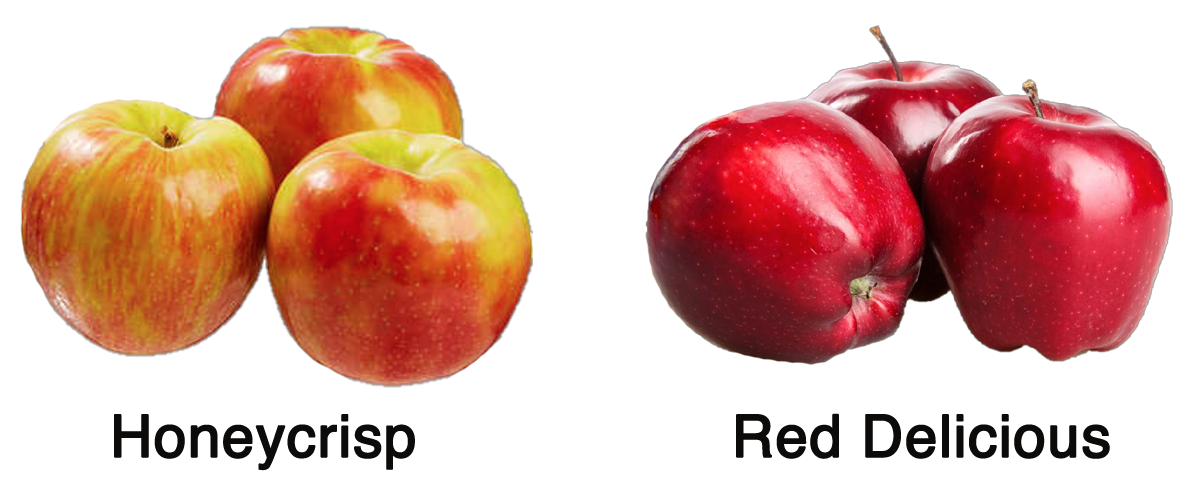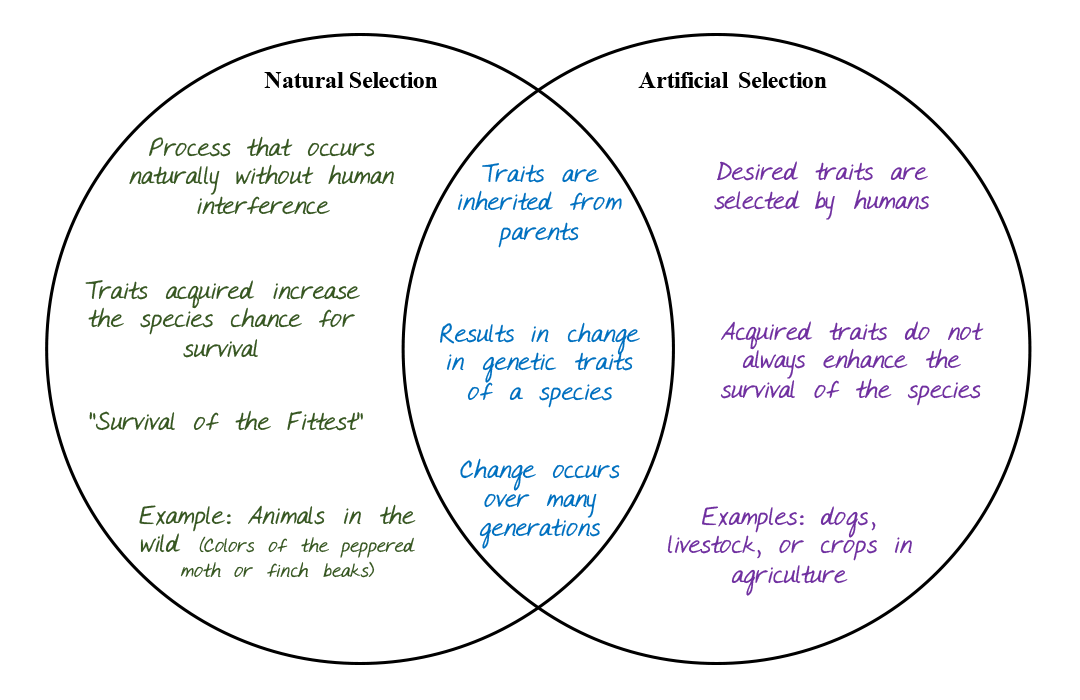 Relevancy and Engagement
newjersey.agclassroom.org
Relevancy and Engagement
newjersey.agclassroom.org
Apples and the Science of Genetic Selection
Grade Level
Purpose
Students will distinguish between natural and artificial selection and use a student-centered learning activity to see how science and genetics have been used to artificially select apples for specific traits like color, texture, taste, and crispness. Grades 9-12
Estimated Time
Materials Needed
- Apples and the Science of Selection handout, 1 copy per student
- Station Cards, 1 copy per class printed front to back
- Paper plates, utensils, and napkins as needed for taste testing
- Supplies for each station:
- Station 1:
- Station 1 card
- Story of John Chapman (Johnny Appleseed)
- Crabapples, apple cider, or crabapple jelly to taste.
- Station 2:
- Station 2 card
- How Does it Grow? Apples video
- Device to view video and use for research.
- Station 3:
- Station 3 card
- Device to browse A Guide to the Most Popular Apple Varieties webpage
- ingredients to make homemade applesauce in the microwave, slow cooker, or pressure cooker. Choose the recipe and method that meets your classroom needs.
- Station 4:
- Station 4 card
- Device to view Have We Engineered the Perfect Apple? video
- Samples of Honeycrisp and Red Delicious apples to taste.
- Tip: Expand the taste test to include varieties of apples grown in your region. Check local farmers markets or grocery stores to discover varieties unique to your area.
- Station 5:
- Station 5 card
- Device to view videos:
- Arctic® apple (GM apple) and yellow delicious apples for taste test.
- Station 1:
- Artificial vs Natural Selection Venn Diagram, 1 copy per student
- Venn Diagram Prompts (optional)
- Natural vs Artificial Selection video
Vocabulary
artificial selection: the intentional breeding of plants and animals to produce specific, desirable traits
asexual reproduction: a form of reproduction involving a single parent and producing offspring that are exact genetic duplicates
clone: an organism or cell produced asexually from one ancestor or stock to which they are genetically identical
crossbreeding: selectively breeding two plants or animals of different breeds or cultivars to produce a superior offspring sometimes called a hybrid
evolution: the process by which different kinds of living organisms are thought to have developed and diversified from earlier forms during the history of the earth
natural selection: the process whereby organisms better adapted to their environment tend to survive and produce more offspring; a theory first introduced by Charles Darwin
propagation: the breeding of specimens of a plant or animal by natural processes from the parent stock
sexual reproduction: production of new living organisms by combining genetic information from two individuals of different types resulting in a genetically similar, but different offspring
Did You Know?
- More than 100 varieties of apples are grown commercially in the United States, but a total of 15 popular varieties account for almost 90% of the production of apples.1
- The crabapple is native to North America.2
- If planted from a seed, an apple tree would take four to five years to produce its first fruit.2
Background Agricultural Connections
Species of plants and animals change through time. This evolutionary process can occur as a result of mutation, migration, or genetic drift. However, natural selection is the most probable and accepted cause of evolution. Natural selection can also be known as "survival of the fittest." In other words, the fittest organism in every situation (weather, temperature, protection from predators or disease, etc.) is most likely to survive and pass its genetic traits to the next generation. Artificial selection (or selective breeding), results in changes over time as well, but rather than nature choosing the desirable characteristics, humans do.
The only apples that are native to the United States are crab apples. Apples originated in the Old World and were brought to the Americas as part of the Columbian Exchange. Thousands of varieties of apple exist, though only a handful are likely to be familiar to most consumers.
Washington, New York, and Michigan are the top apple producing states in America. Although apples are grown in almost every state, not every state produces apples on a commercial level. Apple trees require an annual cold period in order to set fruit and produce a viable crop. Therefore, states with a year-round warm climate are not suited for apple production. Apple trees are propagated by cuttings, a method of asexual reproduction. This allows apple producers to make every Granny Smith apple look and taste the same, since each new tree is produced from a cutting, or clone of the previous. New and improved apple varieties may be developed by propagating apple trees from seed in order to produce an offspring that is genetically different than the parent plants (sexual reproduction). Once a desirable variety is developed through crossbreeding, the tree is propagated by cuttings to produce a uniform crop of apples.
Apples offer an authentic learning connection into scientific concepts, such as investigating states or phases of matter (applesauce), exploring methods of plant propagation (grafting), discovering applications of plant breeding techniques, understanding genetics and heredity, and biotechnology. In this lesson, students will rotate between five stations that introduce them to these scientific connections.
| This lesson could be used to introduce a phenomena storyline to investigate several questions (episodes) in relation to apples and science phenomena. For example: Why do apples brown? Why do apple farmers use grafting to propagate new trees? How does every [Granny Smith] apple look and taste the same? etc. For more information about phenomena storylines visit nextgenstorylines.org. |
Engage
This lesson has been adapted for online instruction and can be found on the 9-12th grade eLearning site.
- Ask students to raise their hand if they have recently eaten a Red Delicious apple. Ask a student to describe what it looked and tasted like.
- Ask students to raise their hand if they have recently eaten a Honeycrisp apple. Ask a student to describe what it looked and tasted like.
- Continue a class discussion comparing varieties of apples. What qualities make a good apple? What qualities make a poor apple? How many varieties of apples are there? How are different varieties of apples developed? What will apples be like in the future? Can science explain why different varieties of apples taste different?
- Conclude your discussion with the final question, "Are apples different today because of something humans have done or because of something that occurred naturally (without human intervention)?" Leave the question open-ended and inform students that you will return to it after the activity.

Explore and Explain
Preparation: Prior to class, set up five stations around the classroom. Each station should have the supplies listed above in the Materials section of the lesson plan.
- Give each student one copy of the Apples and the Science of Selection handout.
- Divide the class into 5 equal groups and assign each group a specific station for their first rotation.
- Give a brief introduction to students by explaining that they will be rotating through 5 stations. They will have approximately 10-15 minutes at each station to read the station card and complete the three tasks listed on the back. Students will need their handout and a writing utensil to begin.
- Set a timer. Consider projecting it in the classroom to allow students to gauge their time at each station. After the time is up, groups should move in a sequential direction. Reset the timer and continue until all groups visit all five stations.
- Once students have come back together, re-ask the question, "Are apples different today because of something humans have done or because of something that occurred naturally (without human intervention)?" (They are a result of what humans have done, also known as artificial selection.)
- Show the video, Natural Selection vs Artificial Selection.
- Give each student one copy of the Artificial vs Natural Selection Venn Diagram. Have students identify the differences and similarities between the two forms of selection. If helpful, use the attached Venn Diagram Prompts and instruct students to sort the statements to the correct area of the venn diagram.

|
Three Dimensional Learning Proficiency: Disciplnary Core Ideas Natural Selection: Natural selection occurs only if there is both (1) variation in the genetic information between organisms in a population and (2) variation in the expression of that genetic information - that is trait variation that leads to differences in performance among individuals. |
Elaborate
-
Have students interview staff and administration about their knowledge and opinions on genetically engineered products.
-
Have students visit the US Apple Association's Popular Varieties webpage to explore apple recipes and watch short video clips about popular apple varieties in the United States.
-
Listen to the NPR Planet Money podcast The Miracle Apple to hear the story of the development of new varieties of apples.
-
Research the crossbreeding behind apple varieties. Suggested varieties include: Honeycrisp, Zestar, SweeTango, SnowSweet, Frostbite, and Minnehaha.
-
Tour a local apple orchard to view apple production first hand.
-
Practice grafting with apple trees, bring in a community expert for additional help.
-
Pair students and assign each pair a breeding technology from the Crop Modification Techniques Infographic. Have them research and present their findings in a gallery walk.
Evaluate
After completing these activities, review and summarize the following key concepts:
- Apples have a long history of importance and selective breeding in the United States.
- Most apple trees today are grown through grafting, a method of asexual propagation to reduce genetic variability in apple varieties. This allows every apple of a specific variety to taste and look the same.
- In apples, characteristics such as color, texture, sweetness/tartness, juiciness, and crunchiness are determined by the genetic make-up of the apple.
- Scientists use a knowledge of genetics and heredity to crossbreed apples (using seed, or sexual propagation) to produce new varieties of apples.
- Genetic engineering is a tool used in plant and sometimes animal breeding. One variety of apple, the Arctic® apple, was genetically modified so that it does not brown when it is cut. All other apple varieties were created through crossbreeding and artificial selection.